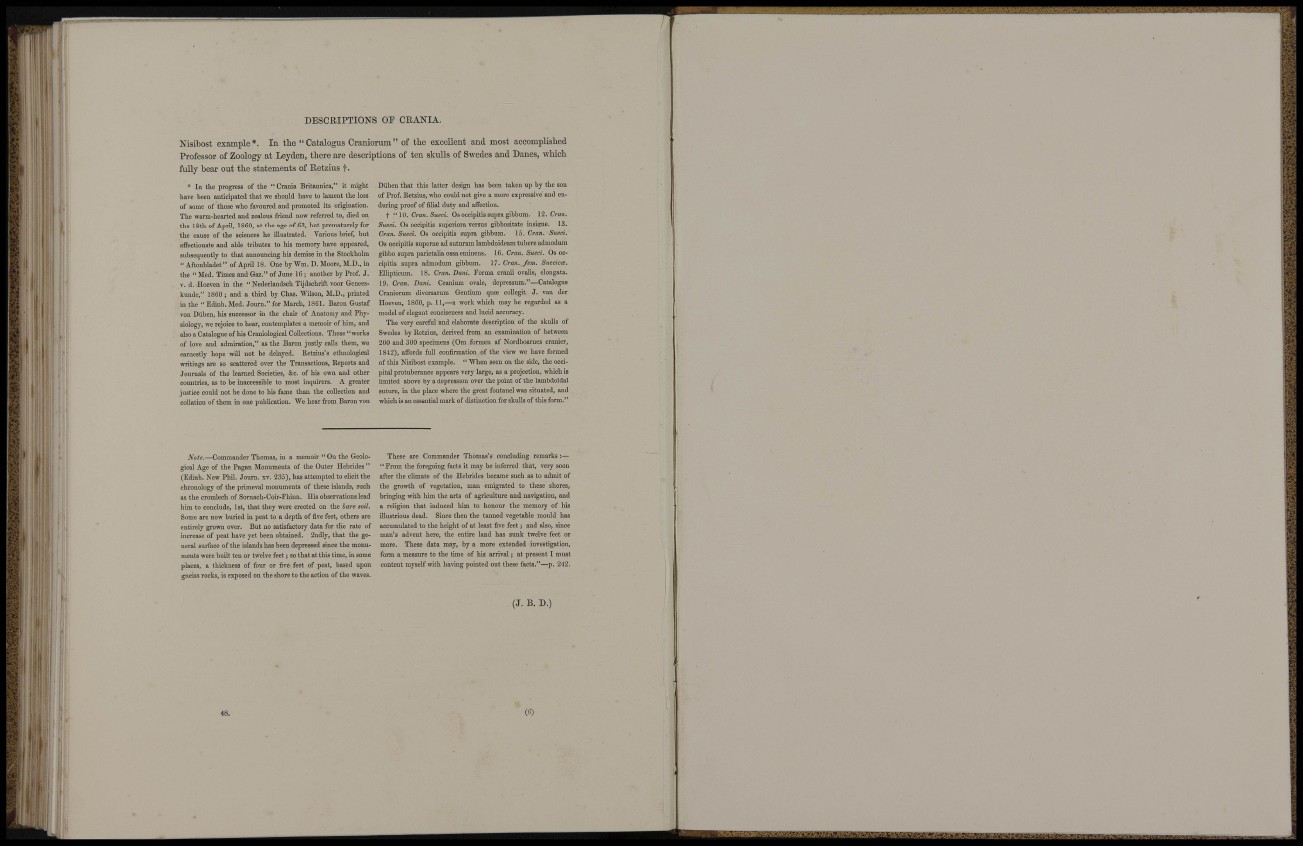
m I'-«*-
I I
I9i ^ m
DESCRIPTIONS OP CRANIA.
Nisibost example *. In the " Catalogus Craniomm" of the excellent and most accomplished
Professor of Zoology at Leyden, there are descriptions of ten skuUs of Swedes and Danes, which
fully bear out the statements of Retzius t-
* In the progress of the " Crania Britannica," it might
have been anticipated that we should have to lament the loss
of some of those who favoured and promoted its origination.
The warm-hearted and zealous friend now referred to, died on
the 18th of April, 1860, at the age of 63, hut prematurely for
the cause of the sciences he illustrated. Various brief, hut
affectionate and able tributes to his memoiy have appeared,
subsequently to that announcing his demise in the Stockholm
" Aftonbladet" of April 18. One by Wm. D. Moore, M.D., in
the " Med. Times and Gaz." of June 16 ; another by Prof. J.
V. d. Hoeven in the " Nederlandsch Tijdschrift voor Geneeskunde,"
1860 ; and a third by Chas. Wilson, M.D., printed
in the " Edmb. Med. Journ." for March, 1861. Baron Gustaf
von Düben, his successor in the chair of Anatomy and Physiology,
we rejoice to hear, contemplates a memoir of him, and
also a Catalogue of his Craniologieal Collections. These "works
of love and admiration," as the Baron justly calls them, we
earnestly hope will not be delayed. Eetzius's ethnological
writings are so scattered over the Transactions, Reports and
Journals of the learned Societies, &c. of his own and other
countries, as to be inaccessible to most inquirers. A greater
justice could not be done to his fame than the collection and
collation of them in one publication. We hear from Baron von
Düben that this latter design has been taken up by the sou
of Prof. Retzius, who could not give a more expressive and enduring
proof of filial duty and affection.
t "10. Cran.Sueei. Os occipitis supra gihbum. 12. Cran.
Sued. Os occipitis snperiora versus gibbositate insigue. 13.
Cran. Sued. Os occipitis supra gibbum. 15. Cran. Sued.
Os occipitis supeme ad suturam lambdoideam tubere admodum
gibbo supra parietaha ossa eminens. 16. Cran. Sued. Os occipitis
supra admodum gibbum. 17. Cran. fem. Buedets.
ElKpticum. 18. Cran. Dam'. Forma cranii ovalis, elongata.
19. Cran. Dani. Cranium ovale, depressum."—Catalogus
Craniorum diversarum Gentium quee coUegit J. van der
Hoeven, 1860, p. 11,—a work which may be regarded as a
model of elegant conciseness and lucid accuracy.
The very careful and elaborate description of the skulls of
Swedes by Retzius, derived from an examination of between
200 and 300 specimens (Om formen af Nordhoarnes cranier,
1842), affords full confirmation of the view we have formed
of this Nisibost example. " When seen on the side, the occipital
protuberance appears very large, as a projection, which is
limited above by a depression over the point of the lambdoidal
suture, in the place where the great fontanel was situated, and
which is an essential mark of distinction for skulls of this form."
Note.—Commander Thomas, in a memoir " On the Geological
Age of the Pagan Monuments of the Outer Hebrides "
(Edinb. New Phil. Joum. xv. 235), has attempted to eUcit the
chronology of the primeval monuments of these islands, such
as the cromlech of Sornaeh-Cour-Fhinn. His observations lead
him to conclude, 1st, that they were erected on the bare soil.
Some are now buried in peat to a depth of five feet, others are
entirely grown over. But no satisfactory data for the rate of
increase of peat have yet been obtained. 2ndly, that the general
surface of the islands has been depressed since the monuments
were built ten or twelve feet; so that at this time, in some
places, a thickness of four or five feet of peat, based upon
gneiss rocks, is e.xposed on the shore to the action of the waves.
These are Commander Thomas's concluding remarks:—
" From the foregoing facts it may be inferred that, very soon
after the climate of the Hebrides became such as to admit of
the growth of vegetation, man emigrated to these shores,
bringing with him the arts of agriculture and navigation, and
a religion that induced him to honour the memory of his
illustrious dead. Since then the tanned vegetable mould has
accumulated to the height of at least five feet i and also, since
man's advent here, the entire land has sunk twelve feet or
more. These data may, by a more extended investigation,
form a measure to the time of his arrival; at present I must
content myself with having pointed out these facts."—p. 242.
(J. B. D.)
m
ll'i
48. (6)
mM
m